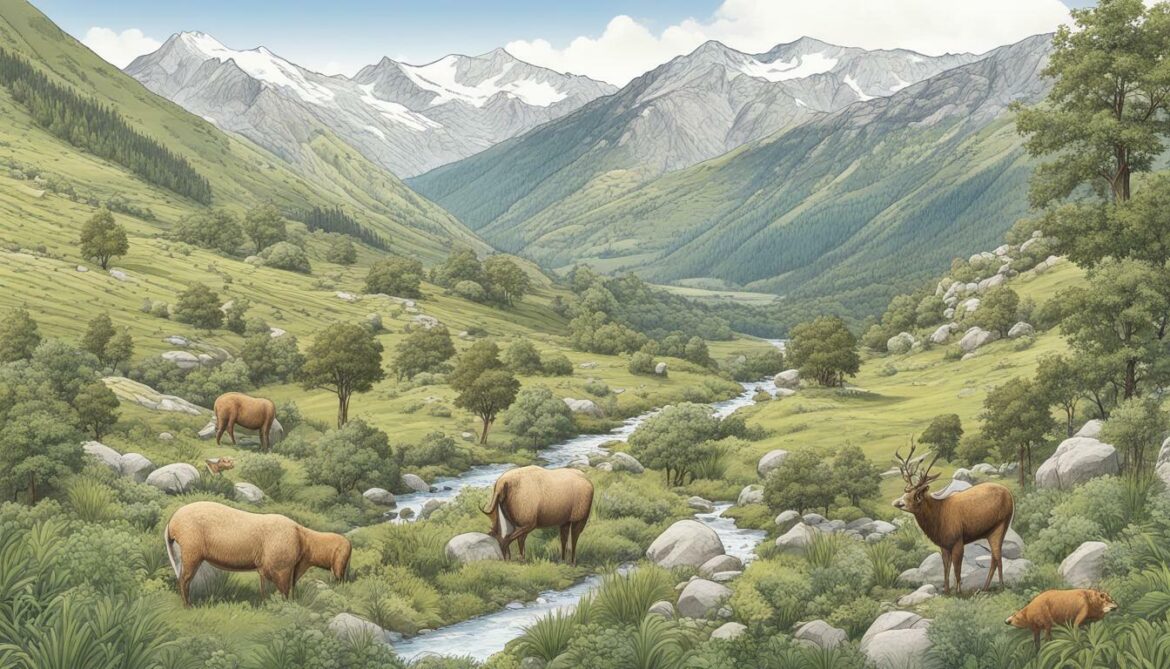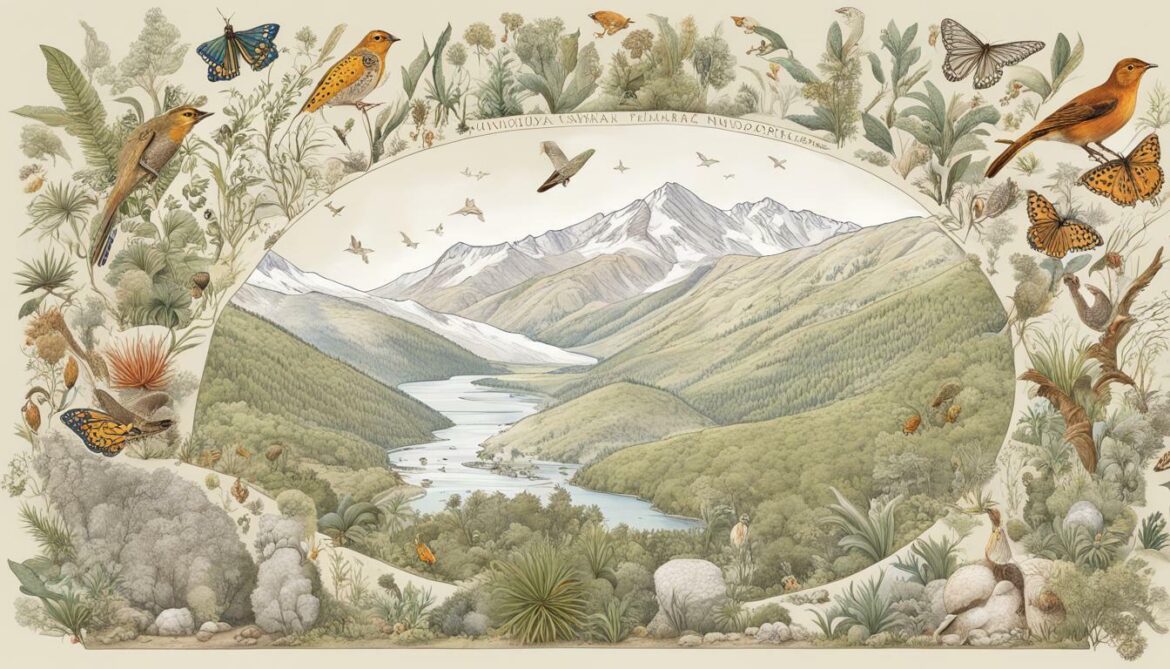Andorra, a small European country nestled in the Pyrenees mountains, is home to a rich diversity of animal and plant species. Its varied landscapes, from rugged mountains to wetlands and forests, provide a range of habitats for unique wildlife. However, this biodiversity is under threat due to various factors such as habitat destruction, climate change, and pollution.
Efforts are underway to understand, protect, and conserve Andorra’s biodiversity. In this article, we will explore the biodiversity of Andorra, the endangered species and their conservation efforts, the ecological importance of biodiversity, and the initiatives being taken to conserve it. We will also identify the biodiversity hotspots in Andorra and the need for their preservation.
Key Takeaways:
- Andorra is home to a diverse range of animal and plant species.
- Habitat destruction, climate change, and pollution are some of the threats to Andorra’s biodiversity.
- Efforts are being made to conserve Andorra’s biodiversity through research and initiatives.
Exploring Andorra’s Wildlife and Natural Habitats
Andorra is home to a diverse array of wildlife and natural habitats, making it an important location for biodiversity research and conservation efforts. From the rugged mountains to the lush valleys, Andorra’s natural landscapes provide a home for a variety of plant and animal species.
The country’s alpine forests are home to species such as the Pyrenean Oak, the European Silver Fir, and the Mountain Pine. These forests provide important habitat for animals such as the Pyrenean Chamois, the Roe Deer, and the Red Squirrel. The rivers and streams that flow throughout Andorra provide habitat for fish such as the Brown Trout and the Barbel.
Andorra’s unique location in the Pyrenees mountains means it has a high level of endemism, meaning there are many species that are found only in this region. Some of these unique species include the Pyrenean Brook Salamander, the Pyrenean Desman, and the Andorran Brook Newt.
Biodiversity research is integral to understanding and protecting Andorra’s wildlife and natural habitats. Ongoing research efforts include studies on the impacts of climate change on mountain ecosystems, the effects of habitat fragmentation on species populations, and the identification of important biodiversity hotspots.

Preserving Andorra’s Natural Habitats
Preserving Andorra’s natural habitats is crucial for protecting the country’s biodiversity. The government of Andorra has taken steps to protect these habitats through the establishment of several nature reserves and protected areas, such as the Madriu-Perafita-Claror Valley, which was designated a UNESCO World Heritage Site in 2004.
Conservation organizations such as the Andorran Wildlife Association and the Pyrenean Institute of Ecology are also involved in biodiversity conservation efforts in Andorra. These organizations work to protect endangered species and their habitats, monitor the health of ecosystems, and raise awareness about the importance of biodiversity conservation.
Overall, Andorra’s wildlife and natural habitats are an important aspect of the country’s identity and culture. Preserving biodiversity in Andorra is essential for maintaining the health of ecosystems and ensuring the long-term survival of unique plant and animal species.
Endangered Species in Andorra
Andorra is home to several endangered species that are threatened by habitat loss and degradation. One such species is the Pyrenean desman, a small semi-aquatic mammal that inhabits the streams and rivers of the Pyrenees Mountains. Its habitat is under threat due to the construction of dams and water pollution. Another endangered species found in Andorra is the bearded vulture, a bird of prey that has suffered from habitat loss and persecution.
Conservation efforts are underway to protect these endangered species and their habitats. The Andorran government has established protected areas, such as the Madriu-Perafita-Claror Valley, to preserve critical habitats. Additionally, conservation organizations are working to restore degraded habitats and monitor endangered species populations.
The conservation of endangered species is crucial for the long-term survival of Andorra’s biodiversity. It provides numerous ecological, social, and economic benefits, such as maintaining healthy ecosystems, providing clean air and water, and supporting tourism.

“The loss of biodiversity is not just a conservation issue; it is also a development issue, a security issue, and a moral issue. We need to live in harmony with nature and preserve the web of life that sustains us all.” – Ban Ki-moon
The Ecological Importance of Andorra’s Biodiversity
Andorra’s biodiversity is not only important for the survival of its unique animal and plant species but also for the overall health and functioning of the ecosystem. The diversity of species and their interactions contribute to the stability and resilience of ecosystems, allowing them to adapt to changes and disturbances.
Biodiversity also provides numerous ecosystem services that benefit humans, including clean air and water, climate regulation, and nutrient cycling. These services are essential for human well-being and economic development. For example, the tourism industry in Andorra relies heavily on the country’s natural beauty and biodiversity.
However, biodiversity is under threat from human activities such as habitat destruction, pollution, and climate change. These threats not only affect the survival of individual species but also the entire ecosystem and the services it provides. It is therefore crucial to conserve biodiversity to maintain these ecological services and ensure their continued provision for future generations.
Conservation efforts aimed at protecting biodiversity in Andorra include the establishment of protected areas, restoration of degraded habitats, and the implementation of sustainable land-use practices. These initiatives are essential to safeguarding Andorra’s biodiversity and the ecosystem services it provides.

In addition, research is essential for better understanding the ecological importance of biodiversity and the threats it faces. Ongoing research in Andorra is focused on identifying key biodiversity areas, monitoring species populations, and assessing the impacts of human activities on the ecosystem. This research is critical for informing conservation policies and management strategies.
Biodiversity Research and Initiatives in Andorra
Andorra’s unique biodiversity has attracted scientists and conservation organizations from around the world, resulting in a variety of research and conservation initiatives.
One such initiative is the Andorra Biodiversity Monitoring Program, which was established in 2014 to monitor changes in Andorra’s biodiversity over time. The program employs a variety of scientific methods, including DNA analysis and remote sensing, to evaluate the health and diversity of Andorra’s ecosystems. The program’s findings are used to inform conservation efforts and policies.
Another initiative is the Andorra Sustainable Tourism Observatory. This program focuses on sustainable tourism practices that minimize the impact on Andorra’s fragile ecosystems. The program provides guidance to tourism operators and visitors on how to enjoy Andorra’s natural beauty while preserving its biodiversity.
Andorra is also home to the Andorra Center for Biodiversity Research and Conservation. This research center focuses on understanding the ecological processes that support Andorra’s unique biodiversity and developing strategies to protect it. The center collaborates with international partners on a variety of research projects, including studies on the impact of climate change on Andorra’s ecosystems.

The Andorran government is also committed to biodiversity conservation, with policies in place to protect sensitive ecosystems and endangered species. The government works closely with scientists and conservation organizations to develop effective conservation strategies.
Overall, the various research and conservation initiatives in Andorra are essential for understanding and protecting the country’s unique biodiversity. By collaborating with international partners and employing cutting-edge scientific methods, researchers and conservationists can ensure the long-term survival of Andorra’s ecosystems and the species that call them home.
Biodiversity Hotspots in Andorra
Andorra is a country known for its rich biodiversity, with various hotspots spread throughout the country. These hotspots are areas that contain a high concentration of species, making them of particular importance for conservation efforts.
One such hotspot in Andorra is the Madriu-Perafita-Claror Valley, which was designated as a UNESCO World Heritage Site in 2004 due to its exceptional natural beauty and high biodiversity. The valley contains a wide range of habitats, including subalpine and alpine meadows, forests, and rocky cliffs, which support a diverse range of plant and animal species.
The Coma Pedrosa-Pic del Pla de l’Estany Natural Park is another important hotspot, located in the northwest of Andorra. This park is characterized by high peaks, gorges, and rivers, and provides habitat for several rare and endemic plant and animal species.
The Estany de l’Illa Nature Reserve, situated in the northeast of Andorra, is also considered an important hotspot. The reserve contains a large lake surrounded by diverse habitats, including wetlands, forests, and rocky areas, which support a variety of plant and animal species.

These biodiversity hotspots in Andorra are crucial areas that require special attention to protect and conserve their unique flora and fauna. Several conservation initiatives and research projects are currently underway in these areas, aimed at better understanding and conserving the biodiversity present in Andorra’s hotspots.
Conclusion
In conclusion, Andorra’s biodiversity is a valuable asset that provides many benefits to both the environment and humans. From its diverse animal and plant species to its vital natural habitats, Andorra’s ecosystems are an essential part of the region’s identity and heritage. Therefore, it is crucial to continue efforts to protect Andorra’s biodiversity from threats such as habitat loss and climate change.
The conservation efforts being undertaken in Andorra play an essential role in protecting the region’s endangered species and biodiversity hotspots. Continued research and initiatives must be prioritized to ensure the long-term survival of Andorra’s biodiversity and the benefits it provides. We must all play our part in supporting these conservation efforts and promoting the appreciation of Andorra’s unique biodiversity.
FAQ
Q: What is biodiversity?
A: Biodiversity refers to the variety of life on Earth, including all living organisms such as animals, plants, fungi, and microorganisms, as well as the ecosystems and ecological processes they are a part of.
Q: Why is biodiversity important?
A: Biodiversity is crucial for maintaining the health and balance of ecosystems. It provides various ecological services, such as pollination, nutrient cycling, and pest control, which are essential for human survival. Biodiversity also offers aesthetic, cultural, and economic benefits.
Q: What are the threats to Andorra’s biodiversity?
A: Andorra’s biodiversity faces several threats, including habitat loss due to urbanization and infrastructure development, climate change, pollution, invasive species, and overexploitation of natural resources. These threats can disrupt ecosystems and lead to the decline of species.
Q: What conservation efforts are in place to protect Andorra’s biodiversity?
A: Andorra has implemented various conservation initiatives, including the establishment of protected areas and nature reserves, promoting sustainable land and resource management practices, and raising awareness about the importance of biodiversity conservation among the public and policymakers.
Q: How can I contribute to biodiversity conservation in Andorra?
A: You can contribute to biodiversity conservation in Andorra by supporting local conservation organizations, practicing sustainable behaviors such as recycling and reducing your ecological footprint, and educating others about the importance of biodiversity and the need for its protection.























Post comments (0)